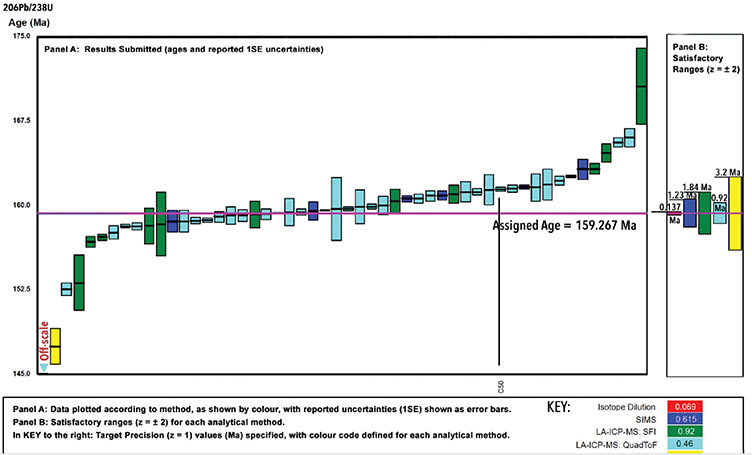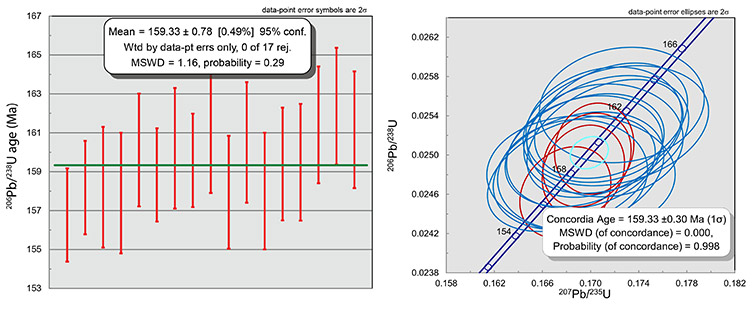Conventional geochronometers with negligible common-Pb
zircon, baddeleyite, monazite & xenotime
Standards we use:
- Zircon: FC1 (1099), 91500 (1065 Ma), Plesovice (337 Ma), BB (565 Ma), Kara-18 (2635 Ma), GSCz1242 (2679 Ma), , KVT (3226 Ma),
- Baddeleyite: FC1 (1099), Phalabowra (2059 Ma)
- Monazite: GSC8153, 44069, Diamantina, Thompson Mine, Trebilcock
- Xenotime: GSC6413, Datas
General U-(Th)-Pb dating
Routine laser ablation geochronology of zircon, baddeleyite, monazite and xenotime is now carried out on the Agilent 8900 instrument using ‘single-quad’ mode: Q1 and the ORS act as simple ion guides and Q2 is used for mass filtering. Crater sizes and other operating conditions vary depending on the size of mineral targets, internal zoning features, U concentration and expected age. For zircon and baddeleyite we typically analyze with crater diameter between 15-30 µm. In extreme cases we can push this to 10 µm if we can obtain sufficient signal (ideally >1000 cps) for 207Pb. Monazite and xenotime can be analyzed with craters down to 5 µm diameter because of their higher U, Th, and Pb* concentrations.
High quality LA ICP-MS geochronology results are best achieved by guiding the selection of target locations using combinations of µ-XRF, optical (TL and RL), BSE, and CL images or LAICPMS trace element maps. For polished thin sections, wide area µ-XRF maps place target minerals in broader textural context whereas the other techniques reveal details of internal zoning. The spatial resolution now achieved by LA QQQ-ICP-MS demands rigorous imaging and interpretation of internal zoning domains.

Removal of 204Hg interference for accurate 204Pb correction
For young zircon targets, even small amounts of 204Pb contamination can push isotope ratios (mostly 207Pb/235U) off Concordia. In cases where accurate measurement of 204Pb contamination is critical, the Agilent 8900 is operated in MS/MS mode and a small flow of NH3 in the reaction/collision cell can be used to effectively eliminate 204Hg interfering on 204Pb: Hg reacts strongly with NH3 whereas Pb intensities are preserved at >85% levels. The combined He + NH3 in the cell does cause some reaction with U and care needs to be taken to adjust ORS settings to ensure appropriate sensitivity for 238U and 232U. This setup is most appropriate for crater sizes >20 µm. A recent run in this mode using a 26 µm crater achieved 204Pb average detection limit of 0.038 ppm and accurately corrected data points with between 2 and 5 cps net 204Pb.
2024 G-chron proficiency testing results
The UNB Mantis lab participates in the International Association of Geoanalysis (IAG) proficiency testing program for geochronology (http://www.gchron.info/default.asp). An excerpt of results of the most recent round of testing on PENG-16 zircon material are shown below. Our lab (randomized as lab C50) achieved a perfect score for reported 207Pb/206Pb and 208Pb/232Th isotopic ages and ratios. Our results for 206Pb/238U isotopic age and ratio was somewhat higher than expected but this is a result of reporting all data (n = 54) within 2% of the concordia curve. This biased the mean 206Pb/238U because of a number of reversely discordant data resulting from standard-sample matrix mismatch. Filtering the data to consider only those analyses within 0.5% of the concordia curve (n =17) produces a weighted mean 206Pb/238U age of 159.33 ± 0.39 Ma (1σ). The resulting weighted mean concordia age is 159.33± 0.31 Ma (1σ). This is perfectly in line with the proposed TIMS age of 159.267 Ma.
This round of G-chron proficiency testing has taught us that the most accurate U-Pb dates for young zircon grains should be based on the most concordant data (<0.5% discordant). The PENG-16 standard will now be used to date young geological systems.


2022 G-chron proficiency testing results
The UNB Mantis lab participates in the International Association of Geoanalysis (IAG) proficiency testing program for geochronology. An excerpt of results of the most recent round of testing on Kara-18 Archean zircon material are shown below. Our lab (randomized as lab B60) was one of the 14 out of 50 labs worldwide that achieved a perfect z-score for both reported isotopic ages and ratios.


Split-stream zircon dating
Split-stream (SS) zircon dating is carried out with the 7700x ICP-MS dedicated to trace-element quantification and the 8900 QQQ-ICP-MS dedicated to U-Th-Pb ratio measurement. Despite halving the ablated material travelling to each instrument, the 8900 is still able to achieve sensitivity on 207Pb that is on par with what we historically measure on the 7700x on its own. For Proterozoic and older zircon we can operate in SS mode with laser crater diameters ranging from 10-20 micron and ablation times of 30sec. Younger zircons require commensurably larger craters to achieve suitable internal precision. A typical TE element list on the 7700x includes: Si, P, Ca, Sc, Ti, Y, Zr, Nb, Hf, and REE. The 8900 simultaneously measures: Zr (guide mass), 202Hg, 204Pb, 206Pb, 207Pb, 208Pb, 232Th and 238U.

